Have you ever wished for an AI-powered assistant that could assist you in various tasks with just a few keystrokes? Look no further because ChatGPT is here to grant your digital wishes.
In this in-depth article, we will delve into the extraordinary world of ChatGPT, unraveling its potential for beginners and seasoned users alike.
We'll walk you through every step, from getting started to crafting effective prompts, editing responses, and leveraging ChatGPT's power for productivity. By the end, you'll be equipped with practical tips and strategies that’ll empower you to make the most of this AI marvel.
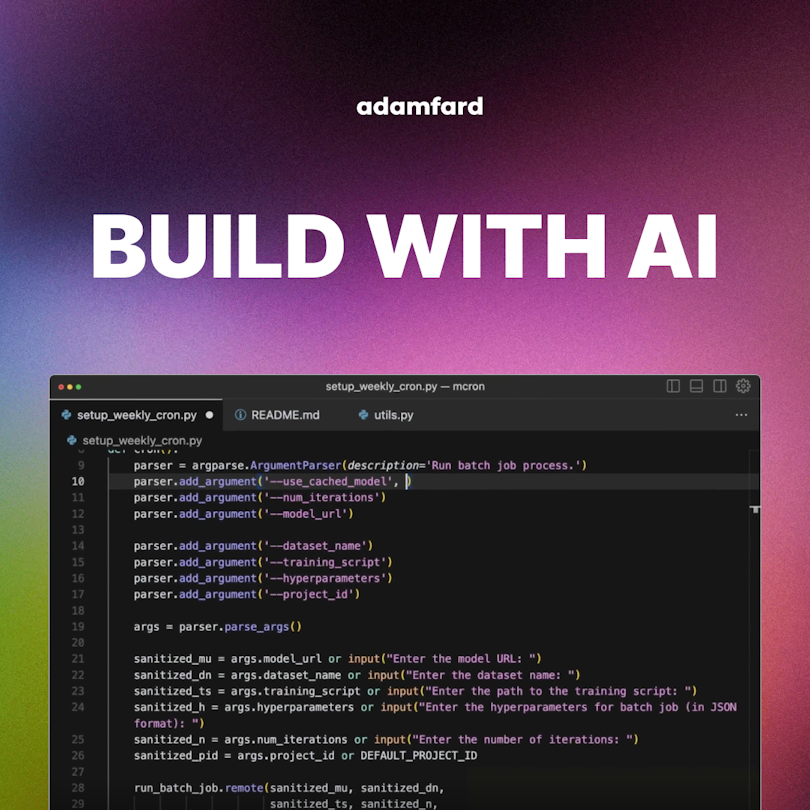
Code & Build Your Startup with AI
The only course you'll ever need to master AI for building products.
Join the WaitlistWhat exactly is ChatGPT?
ChatGPT is a groundbreaking natural language AI chatbot. It's a piece of the most advanced technology that's available now. It's not just an automated system that responds to your messages. It's about entering the world of AI that can comprehend how to interact, as well as behave as humans. The marvel of OpenAI isn't just a technology marvel, it's also an interplay between human brains and AI.
Overview of OpenAI’s ChatGPT
What's the deal with ChatGPT? Well, Imagine it as an electronic friend who's available to help, chat, and even entertain. Whether it's writing an email, composing stories, or giving information, ChatGPT does it with the flair of a computer that's hard to differentiate from a person. This isn't only about answering your questions and interpreting the context, emotions, and nuance. ChatGPT is more than an instrument and a glimpse into the future in which AI assists us in ways we've only dreamed of.
Who Created ChatGPT?
ChatGPT was developed by OpenAI, an AI research lab based in San Francisco. Initially established as a non-profit for collaborative purposes with various institutions and researchers, it received funding from notable individuals including Peter Thiel and Elon Musk.
In 2019, OpenAI transitioned into a for-profit entity, currently under the leadership of CEO Sam Altman. The organization leverages Microsoft’s Azure infrastructure and utilizes Nvidia’s GPUs for its operations, including the latest supercomputers announced this year. Microsoft has been a significant investor in OpenAI since 2019.

Getting Started with ChatGPT
Ready to start chatting with an AI that's nearly indistinguishable from humans? Well, setting up your account available is the very first stage in opening the world of AI chat. It's more than just setting the account. It's about opening the door to endless possibilities as the digital world becomes an integral part of your routine.
Setting Up Your ChatGPT Account
This process is streamlined and user-friendly, akin to starting a new social media account, but with a twist of futuristic AI interaction. Sign up using your email, or conveniently link your Google or Microsoft account, and you're set to explore the realm of intelligent conversations.

ChatGPT: Free vs. Paid Plans
ChatGPT offers both free and paid plans, catering to diverse user needs. The free version is a treasure trove of AI capabilities, perfect for casual exploration and routine tasks. It's like having a versatile AI companion without any cost.
For those craving more, the paid plans elevate your experience. They unlock faster response times, priority access to new features, and the advanced prowess of the latest GPT models. It's a premium AI journey, enhancing every interaction with superior performance and exclusive features.
Choosing between these plans depends on your requirements and curiosity level. Regardless of your choice, ChatGPT promises a unique and enriching journey into the world of AI, making every conversation a step into an innovative digital terrain.

Accessing ChatGPT
Accessing ChatGPT opens a door to AI conversations that feel as natural as chatting with a friend. The ChatGPT website, sleek and intuitive, is your digital command center. Here, you can engage with ChatGPT, exploring its language understanding and response capabilities. It's like a crystal ball, but for language, offering advice, generating content, or simply having a meaningful conversation.
Navigating the ChatGPT Website
Navigating the ChatGPT website is your first step into the AI world. The user-friendly interface is your guide to engaging with AI, exploring its diverse functionalities, and experiencing the power of natural language processing. It's an interactive journey where every click brings you closer to understanding AI's potential in everyday conversations.
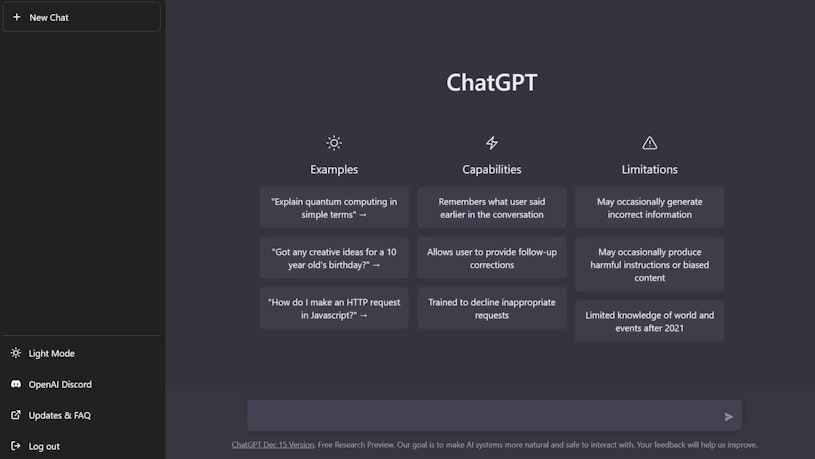
Downloading and Using the ChatGPT Mobile App
For those on the move, the ChatGPT mobile app brings AI interaction to your fingertips. Available for both iOS and Android users, downloading and using the app is a smooth experience. It’s like carrying a personal AI assistant in your pocket, ready to assist with creative ideas or urgent queries anytime, anywhere.
The app’s intuitive design ensures your AI interactions are both smooth and engaging, making it feel like conversing with a friend. With advanced AI technology at your beck and call, the app is a versatile tool for various tasks and inquiries.
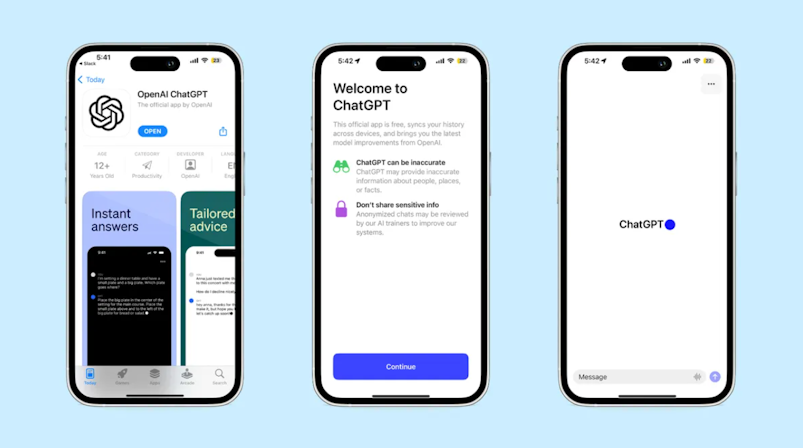
Mastering the Basics of ChatGPT
Writing Effective Prompts for ChatGPT
Entering the realm of ChatGPT requires a key skill: writing effective prompts. This is like learning to speak a new language, one that bridges the gap between human thought and AI understanding. The art of prompt writing determines the quality of your ChatGPT experience. It’s about striking a balance between clarity and creativity to elicit the best possible responses.
Crafting Clear and Concise Queries
Imagine crafting a prompt as if you're a sculptor chiseling away at a block of marble. Each word should be thoughtfully chosen, aiming for clarity and precision. Clear and concise queries are the pillars of successful interactions with ChatGPT. It’s about being direct yet detailed, guiding the AI to understand your exact needs without overwhelming it with redundant information.
Examples of Good vs. Bad Prompts
To illustrate, let's compare good and bad prompts. A vague prompt like "Tell me about dogs" might lead to a generic response. In contrast, a well-structured prompt such as "Explain the training methods for service dogs" will yield a focused and informative reply.
Bad prompts often lack specificity or clarity, leading to responses that miss the mark. Good prompts, on the other hand, are specific, clear, and purpose-driven, ensuring that the AI comprehends and addresses your query effectively.
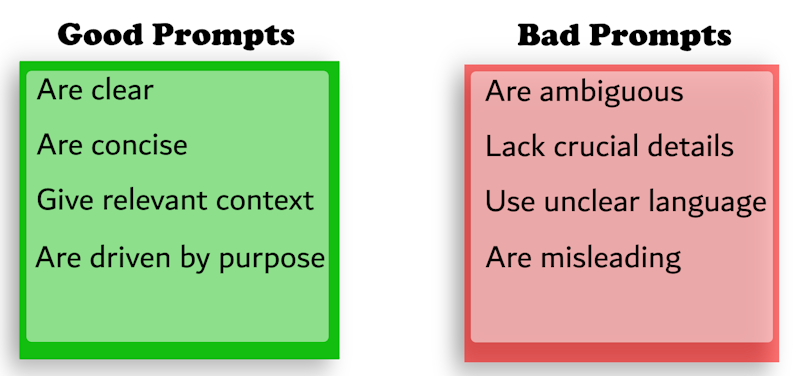
How To Craft An Effective Prompt For ChatGPT
Creating an effective prompt for ChatGPT involves a clear and structured approach. Here's a simple step-by-step framework to guide you in doing that:
Define Your Objective: Identify what you want to achieve with your prompt. It could be seeking information, generating creative content, or solving a specific problem.
Be Specific: Provide detailed information within your prompt. Specificity helps ChatGPT understand exactly what you’re asking for and improves the relevance of the response.
Include Context: If your query is related to a broader topic or a continuation of a previous conversation, include relevant context. This helps ChatGPT to tailor its response more accurately.
Use Simple Language: Write your prompt in clear, straightforward language. Avoid jargon or overly complex sentences unless they are necessary for the context of your query.
Check for Ambiguity: Reread your prompt to ensure there's no ambiguity. Ambiguous prompts can lead to vague or off-topic responses.
Consider the Structure: For complex queries, structure your prompt in an organized manner. Use bullet points or numbered lists if you have multiple questions or several aspects to cover.
Set the Tone: If you have a preference for the response’s tone (formal, informal, humorous, etc.), indicate this in your prompt.
Limit the Scope: Ensure that your prompt isn’t too broad. Focusing on a single topic or question at a time can yield more focused and useful responses.
Preview and Edit: Before submitting, review your prompt. Edit for clarity and conciseness, and to remove any unnecessary details.
Iterate Based on Responses: If the initial response doesn’t fully meet your needs, refine your prompt based on the feedback, and try again.
Remember, effective prompts are the key to getting the most out of ChatGPT. The more precise and well-structured your prompts are, the better the responses you’ll receive.
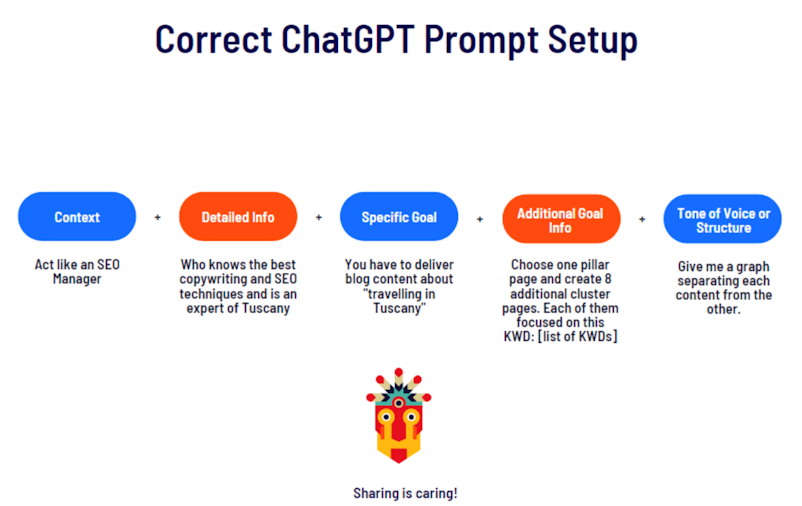
Understanding ChatGPT's Limitations
Recognizing the limitations of ChatGPT is crucial. It's like knowing the strengths and weaknesses of a new gadget. ChatGPT, while advanced, is not infallible. It's essential to have realistic expectations about its capabilities and the nature of its responses.
Realistic Expectations from AI Responses
Approach ChatGPT with an understanding that it’s a tool, not a magic wand. It can provide assistance, generate ideas, and even entertain, but it may not always grasp complex nuances or offer in-depth expertise on every topic. Expectations should align with the reality that ChatGPT is a machine learning model, limited by its training and programming.
Addressing ChatGPT's Hallucination Tendencies
A notable aspect of working with AI models like ChatGPT is their tendency to "hallucinate" – generating information that might sound plausible but isn't factually accurate. This phenomenon occurs when ChatGPT fills gaps in its knowledge base with fabricated information, often presented confidently. Being aware of this tendency is vital for users to critically evaluate the responses they receive, especially when dealing with factual information or specific expertise. It's essential to corroborate critical information from ChatGPT with reliable sources to ensure accuracy.
Ethics and Appropriate Use of AI Chatbots
Navigating the ethical use of ChatGPT is like walking a tightrope. It's a powerful tool, but with great power comes responsibility. Ethical considerations include respecting privacy, avoiding the generation of harmful or inappropriate content, and acknowledging AI's limitations in understanding human emotions and cultural contexts. Using ChatGPT responsibly means recognizing its role as an assistant, not a replacement for human judgment and decision-making.
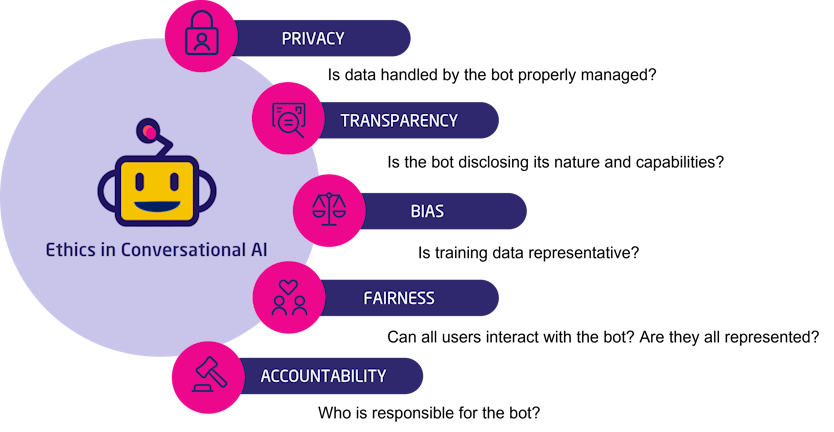
7 Advanced Features of ChatGPT
OpenAI has significantly enhanced ChatGPT with new capabilities that bridge the gap between digital and physical worlds. Here are the key advanced features now available in ChatGPT:
Voice Interaction Capabilities:
Engage in Voice Conversations: Users can now have back-and-forth voice conversations with ChatGPT, making the interaction more natural and intuitive.
Easy Setup for Voice Features: To access voice capabilities, go to Settings → New Features on the mobile app and opt into voice conversations.
Diverse Voice Options: ChatGPT offers a selection of five different voices, created in collaboration with professional voice actors.
Text-to-Speech Model: The new voice feature is powered by an advanced text-to-speech model capable of generating human-like audio.
Image Interaction Enhancements:
Image Conversations: ChatGPT can now understand and discuss images shown by users. This feature is useful for various tasks like meal planning or analyzing work-related data.
Focus with Drawing Tool: A drawing tool in the mobile app allows users to highlight specific parts of an image to guide the AI.
Multimodal Capabilities: The image understanding feature is powered by multimodal GPT-3.5 and GPT-4 models, enabling the AI to process a wide range of images effectively.
Practical Applications:
Travel and Exploration: Users can snap pictures of landmarks while traveling and have real-time discussions about them.
Meal Planning and Recipes: By showing images of pantry items, ChatGPT can assist in meal planning and recipe generation.
Educational Assistance: Helps in educational settings, such as solving math problems through photographed worksheets.
Gradual Rollout and Accessibility:
Phased Introduction: The voice and image features are being introduced gradually to Plus and Enterprise users, ensuring a controlled and safe deployment.
Device Compatibility: Voice is available on iOS and Android with image features accessible on all platforms.
Safety and Ethical Use:
Focused on Safety: OpenAI emphasizes the safe and beneficial development of AGI, introducing new tools cautiously to refine risk mitigations.
Technical Safeguards: Measures have been taken to limit ChatGPT’s ability to analyze and make statements about people, prioritizing privacy and accuracy.
Real-World Testing and Feedback: Features have been tested for risks in various domains, and ongoing user feedback will guide further improvements.
Collaborations and Real-World Use Cases:
Partnerships for Enhanced Experience: Collaborations with companies like Spotify are leveraging these new technologies for innovative applications like Voice Translation features.
Integration with Be My Eyes App: Insights from the Be My Eyes app, which assists blind and low-vision individuals, have informed the development and usage of these features.
Unifying GPT-4 Tools and Collaborations:
All-in-One GPT-4 Tools Access: The latest update in ChatGPT combines all GPT-4 tools, including advanced data analysis, DALL·E 3 (image generation), and browsing capabilities in a unified interface.
Direct Document Analysis: Users can now upload and analyze various document types, like PDFs, directly within the ChatGPT interface, expanding beyond text-based queries.
Streamlined Interaction: The unified approach eliminates the need to switch between different modes, making interactions more efficient.
Insights from Be My Eyes App: The development and usage of ChatGPT's features have been informed by insights from the Be My Eyes app, which assists blind and low-vision individuals.
Real-World Use Cases: The integration of advanced features opens up new possibilities for real-world applications, providing a comprehensive AI experience.
Reduced Reliance on Third-Party Plugins: The update potentially reduces the need for third-party ChatGPT plugins by incorporating these functionalities within the system.
These advanced features of ChatGPT offer a spectrum of applications, both in professional and personal contexts. From revolutionizing business strategies to enriching personal lives, ChatGPT, like many other AI Tools, stands as a testament to the versatility and potential of AI in our everyday existence.
10 Tips and Tricks for Using ChatGPT Effectively
Here are 10 practical tips and tricks for beginners to use ChatGPT effectively:
Start with Clear, Specific Prompts: Clearly state what you need from ChatGPT. Specific prompts lead to more accurate and useful responses.
Use Follow-Up Questions: If the initial response isn't quite what you expected, ask follow-up questions to narrow down the information.
Explore Different Use Cases: Experiment with various tasks like drafting emails, creating outlines, generating ideas, or practicing language skills.
Utilize the “Undo” Feature: If you receive an undesirable response, use the “undo” feature to retract the last prompt and try a different approach.
Provide Context in Prompts: Give sufficient background information in your prompts when asking about complex subjects for more relevant answers.
Experiment with Creative Requests: Challenge ChatGPT with creative tasks such as writing poems, and stories, or even composing music.
Learn Basic Prompt Engineering: Understand the basics of how to construct prompts effectively to get the best out of ChatGPT.
Set Realistic Expectations: Recognize the limitations of ChatGPT and understand that it may not always provide perfect or complete information.
Use ChatGPT for Learning: Ask for explanations on topics you're learning about. It can break down complex concepts into simpler explanations.
Regularly Update Your Queries: As you interact more with ChatGPT, refine your queries based on previous responses to improve the quality of future interactions.
ChatGPT Custom Features
ChatGPT's versatility extends to its array of custom features, including the use of ChatGPT Plugins, allowing for a tailored user experience. This segment delves into personalizing ChatGPT to suit your specific needs, enhancing both functionality and user-friendliness.
5 Ways to Personalize Your ChatGPT Experience
Customizing your ChatGPT experience is a powerful way to make it more relevant and useful for your specific needs. Here are some ways you can personalize your AI experience:
Naming Your GPT: When creating a custom GPT with ChatGPT, you can choose a name that resonates with you or aligns with its intended use.
Selecting a Profile Picture: This visual representation will be displayed if you share your GPT or make it public, giving it a unique identity.
Custom Behavior Settings: You can specify how you want your GPT to behave. This includes giving long descriptions, providing code samples, or avoiding certain topics. This feature is similar to the ChatGPT Custom Instructions feature.
Handling Ambiguous Contexts: Decide how your GPT should react when provided with minimal context - whether to seek clarification or make a guess based on available information.
Choosing the Tone of Conversation: You can set the tone of your GPT to be formal, casual, or something in between, depending on your preference or the intended audience.
Managing ChatGPT Settings for Optimal Use
Effectively managing ChatGPT settings can greatly enhance your experience. Here’s how:
Adjusting Response Length: Tailor the length of responses to suit your needs, whether you prefer concise answers or detailed explanations.
Context Window Management: Manage how much prior conversation context ChatGPT considers in its responses.
Content Filters: Set filters to ensure that the responses from ChatGPT align with your content preferences or guidelines.
Utilizing Plugins: Incorporate additional instructions or plugins to enhance interactions and streamline tasks. This can make the AI-assisted experience more efficient and enjoyable.
These custom features and settings help make ChatGPT a more versatile and user-friendly tool. Whether you're using it for personal or professional purposes, these customization options allow you to tailor the AI to better suit your individual needs and preferences.
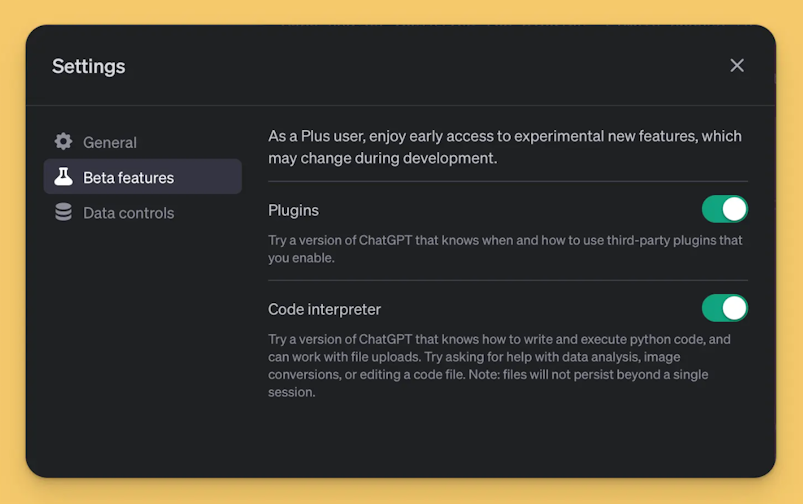
Navigating the 5 Common ChatGPT Challenges
Dealing with Inaccuracies and Biases in AI
Understanding and managing the challenges associated with AI tools like ChatGPT is essential for effective use. Here are five common issues and ways to handle them for a better AI experience:
Identifying and Reporting Issues in AI Systems:
The challenge is to recognize and discern between accurate AI responses and those tainted by misinformation or biases. It requires a keen understanding of the common types of biases in AI.
Users need to be aware of how to report any identified issues or biases to the AI system developers, in this case, OpenAI. This contributes to the ongoing refinement and accuracy of AI models like ChatGPT.
Critical Analysis of AI-Generated Content:
It is essential to critically evaluate the content generated by AI systems. Users should not accept AI responses at face value but should engage with them critically.
This involves separating factual information from potential inaccuracies or biases and understanding the context and limitations of AI-generated responses.
Security and Privacy Concerns with ChatGPT:
As with any digital tool, considerations around security and privacy are paramount when using AI systems like ChatGPT.
Users should be informed about ChatGPT's data handling policies and be proactive in taking steps to secure their personal information.
Safe and Ethical Use of AI Technology:
Ethical considerations include using AI technology responsibly, respecting privacy norms, and avoiding misuse.
It involves understanding the limitations of AI in understanding human emotions and cultural contexts and using it as an assistant rather than a replacement for human judgment.
Hallucination in ChatGPT:
"Hallucination" in AI refers to instances where the AI generates information or data that is not based on its training or factual accuracy. This can lead to misleading or incorrect information being produced.
Users should be aware of this limitation and cross-verify the information provided by AI systems, especially in critical decision-making scenarios.
Addressing these challenges involves a combination of technical solutions, such as improving AI models and training data, and human oversight, where human judgment plays a crucial role in ensuring AI-supported decision-making is fair and ethical
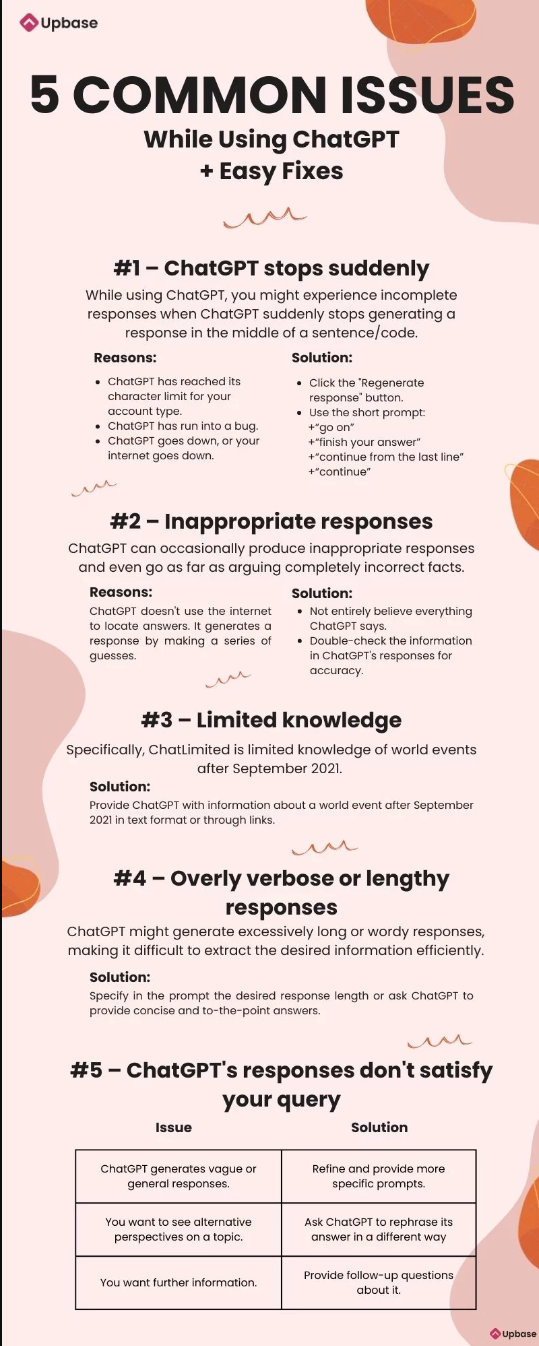
Security and Privacy Concerns with ChatGPT
In the digital age, where AI technologies like ChatGPT are becoming increasingly prevalent, understanding and addressing security and privacy concerns is essential. This section delves into how users can safeguard their data and ensure the ethical use of AI technology.
Protecting Your Data And Privacy
The rise of AI chatbots like ChatGPT underscores the importance of data protection. Users need to be aware of how their data is used and stored, and take proactive steps to protect their personal information.
Understand Data Policies: Familiarize yourself with OpenAI’s data handling and privacy policies. Know what data is collected, how it's used, and the measures taken to protect it.
Secure Interactions: Be cautious about sharing sensitive information in your interactions with ChatGPT. Avoid discussing confidential details that could compromise your privacy.
Use Secure Networks: Access ChatGPT over secure, encrypted connections. Avoid using public Wi-Fi networks for sensitive conversations.
Regular Updates and Vigilance: Keep your software updated, including any applications that integrate with ChatGPT, to protect against security vulnerabilities.
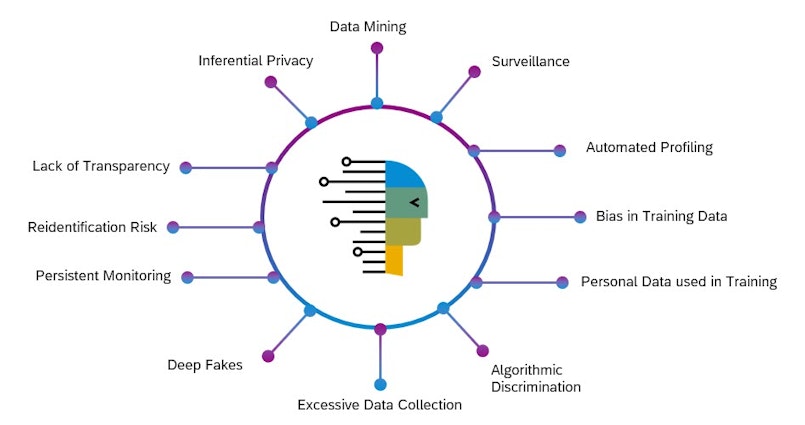
Safe and Ethical Use of AI Technology
The ethical use of AI technology like ChatGPT involves more than just adhering to legal standards; it also encompasses moral responsibility and respect for societal norms.
Responsible Usage: Use ChatGPT in a manner that respects others' privacy and dignity. Refrain from using it to create harmful or offensive content.
Awareness of AI Limitations: Acknowledge that ChatGPT, like all AI models, has limitations and may not always provide accurate or appropriate responses. Use its guidance critically, especially in sensitive or high-stakes scenarios.
Promote Positive Impact: Leverage ChatGPT for purposes that have a positive impact, such as education, creative endeavors, and problem-solving.
Stay Informed about AI Developments: Keep up with the latest developments in AI ethics and governance. Participate in discussions and initiatives aimed at promoting the safe and responsible use of AI technologies.
In conclusion, addressing security and privacy concerns with ChatGPT involves a combination of informed practices, secure data management, and ethical considerations. By taking these measures, users can enjoy the benefits of AI chatbots while minimizing risks and contributing to a safer digital environment.
The Future of ChatGPT and AI Evolution
5 Predictions and Trends in AI
Based on the latest trends and predictions in AI, here are five key developments to watch for:
Emotionally Intelligent AI: Future AI systems may evolve to understand and respond to human emotions more effectively, leading to more empathetic and personalized user experiences. This could revolutionize areas such as mental health care, where AI could provide support by detecting and responding to emotional cues.
AI in Space Exploration: AI could play a crucial role in space exploration, from analyzing vast amounts of astronomical data to autonomously piloting spacecraft. AI might be used to predict and navigate space weather or even assist in finding habitable planets.
Quantum Computing and AI: The integration of quantum computing with AI could lead to exponential growth in AI's problem-solving capabilities. This could unlock new levels of efficiency in fields such as pharmaceuticals, where AI could help design new drugs at unprecedented speeds.
AI-Driven Environmental Solutions: AI could become instrumental in combating climate change by optimizing energy consumption, managing natural resources more efficiently, and even developing new materials for better carbon capture.
AI in Artistic Creation: Beyond just assisting in artistic endeavors, AI might start setting trends in art and music, creating new genres and styles. We could see AI not only generating art but also critiquing and interpreting it, potentially changing our understanding of creativity.
These predictions showcase the potential of AI to not only enhance existing technologies and processes but to create entirely new realms of exploration and understanding in various aspects of our world.
The Role of AI in Shaping the Future
Beyond mere technological advancements, AI is a catalyst for redefining life, work, and interaction paradigms. This segment delves into AI's societal impact, addressing the question 'Will AI replace humans?' and envisaging its transformative effect across industries, job markets, and daily existence.

Preparing for Advanced AI Integration
The rapid evolution of AI technology, particularly platforms like ChatGPT, demands an informed and proactive approach to integration. As we venture deeper into the AI era, two crucial aspects emerge: staying informed and adaptive, and understanding the ethical implications of AI advancements.
Staying Informed And Adaptive
In the ever-changing landscape of AI, keeping up-to-date with the latest advancements is crucial. It's about being proactive in learning new trends, understanding how these changes can impact various sectors, and being ready to adapt to new technologies. This includes:
Regularly following AI news and updates.
Participating in relevant workshops, webinars, or online courses.
Networking with AI professionals and joining AI-focused communities.
Adapting to AI advancements involves more than just understanding the technology. It requires a shift in mindset to embrace AI as a tool that complements human skills, not replaces them. It’s about finding the right balance between automation and human touch, particularly in sectors like healthcare, education, and customer service.
The Ethical Implications of AI's Advancement
The rapid advancement of AI brings a spectrum of ethical considerations that must be addressed. These include:
Data Privacy and Security: As AI systems process vast amounts of data, ensuring the privacy and security of this data is paramount. This involves implementing robust data protection measures and being transparent about data usage.
Bias and Fairness: AI systems are only as unbiased as the data they are trained on. It's vital to continually work towards reducing biases in AI algorithms to ensure fairness and inclusivity.
Impact on Employment: While AI can automate repetitive tasks, there is concern about its impact on jobs. It’s essential to focus on AI as a means to augment human capabilities and re-skill the workforce accordingly.
Accountability: Establishing clear lines of accountability for AI decisions, especially in critical applications like healthcare and law enforcement, is crucial. This involves ensuring that AI systems are explainable and their decisions can be audited.
Moral and Ethical Boundaries: As AI becomes more advanced, setting moral and ethical boundaries for its application is necessary. This includes avoiding the use of AI in scenarios that can harm individuals or society.
In conclusion, preparing for advanced AI integration is a multifaceted endeavor. It requires staying informed and adaptable to technological changes while carefully considering the ethical implications of these advancements. By doing so, we can harness the benefits of AI while mitigating its risks.
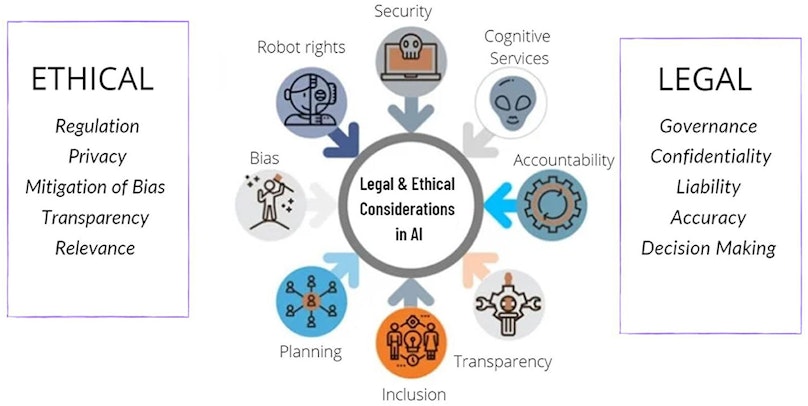
Conclusion
Summarizing the Journey to AI Mastery
Our exploration through the realms of ChatGPT demonstrates not just the capabilities of a revolutionary AI tool, but also the dawn of a new era in human-digital interaction. ChatGPT represents more than just a technological advancement; it symbolizes a shift in how we approach problem-solving, creativity, and daily tasks. This journey to AI mastery underscores the boundless potential that ChatGPT offers, blending human intuition with AI efficiency.
The Importance of Continued Learning and Adaptation
As we embrace this AI revolution, the key lies in our willingness to continuously learn and adapt. The world of AI, especially ChatGPT, is ever-evolving. Staying abreast of these changes and adapting our strategies accordingly ensures that we not only keep pace with AI advancements but also harness their full potential. In this era of rapid digital transformation, our agility and openness to new AI experiences will shape our success in navigating the AI landscape.






